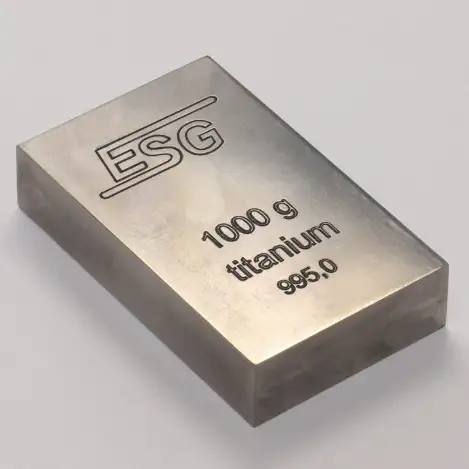Titanium’s high price comes less from scarcity of the element and more from the costly, energy-intensive extraction and processing chain (the Kroll route and subsequent melting/machining), a concentrated supply base with geopolitical sensitivity, and unusually strict quality/traceability demands from aerospace and medical customers — all combined with growing demand and limited high-grade secondary supply. These structural supply-side costs, plus value added by alloying and certification, explain why titanium typically trades at a large premium versus common engineering metals.
What is titanium?
Titanium (Ti) is a transition metal with a best-in-class strength-to-weight ratio, very good corrosion resistance (especially to seawater and many chemicals), and excellent performance at elevated temperatures compared with common steels and aluminum alloys. Commercial engineering grades range from commercially pure (CP) titanium (Grades 1–4) to widely used alloys such as Ti-6Al-4V (also known as TC4 or Grade 5), used where strength, toughness and heat resistance matter.
Why that matters commercially: a kilogram of titanium often replaces two or more kilograms of heavier materials in weight-sensitive applications (airframes, gas turbines), but every kilogram of titanium brought into a finished part requires a long chain of costly processing steps — which is the core of its premium price.
Where titanium comes from — ores, sponge, and producers
-
Ore: Titanium is most commonly recovered from ilmenite (FeTiO₃) and rutile (TiO₂). Ilmenite is abundant worldwide, so “elemental scarcity” is not the main price driver.
-
Sponge: The industry converts ores into titanium sponge (a porous metallic form) which is then melted into ingots and wrought forms. Sponge production is specialized and capital-intensive; only a limited number of large plants produce the bulk of global sponge.
Key geopolitical note: a few major producers (including Russia’s VSMPO-AVISMA, Japan, Kazakhstan, and developing Chinese capacities) dominate the high-quality sponge market. This concentration creates supply risk and price sensitivity when trade flows change. Europe and aerospace manufacturers have repeatedly faced dependency challenges when access to specific high-grade sponge tightened.

The Kroll process and downstream manufacturing
The dominant industrial route to titanium metal is the Kroll process (reduction of TiCl₄ with magnesium in an inert, high-temperature environment), followed by sponge washing, remelting (often in vacuum consumable-arc or electron-beam furnaces), forging/rolling, and precision machining. Important cost drivers:
-
High energy use: Kroll reduction, vacuum melting and hot-working require large, continuous energy inputs. Energy costs feed directly into unit cost.
-
Chemical inputs and materials handling: Producing purified titanium chloride (TiCl₄) requires chlorination steps and tight handling; magnesium and chlorine reagents add cost and environmental controls.
-
Low yields and high scrap risk: Converting sponge to finished mill products often produces off-cuts and swarf; recovery and re-melting add processing time and cost.
-
Specialized equipment and small plant counts: Building a sponge plant or high-vacuum remelt line demands high capital expenditure — that limits supply expansion and keeps margins higher than for commodity metals.
Put another way: titanium’s raw material may be common, but turning it into aerospace-grade alloyed plate, bar or forgings is a sequence of small, expensive steps — each adds both cost and time.
Supply-chain bottlenecks, geopolitics and traceability
-
Concentration of high-grade supply: A handful of producers supply the majority of aerospace-grade sponge and ingots, so any political disruption, sanctions, or trade friction can tighten supply quickly. Recent reporting has underlined Europe’s dependence on Russian titanium and the delicate politics around aerospace sourcing.
-
Traceability & paperwork: Aerospace prime contractors require complete metallurgical records and traceability back to sponge & melts. Recent investigations into falsified paperwork for titanium parts have increased buyer diligence — which raises transaction costs, audit work, and inventory holding costs.
-
Regulatory and quality overhead: Medical implants and aircraft parts are subject to intense regulatory inspection and certification regimes — suppliers that meet these rules command price premiums.
These factors mean that in times of heightened scrutiny or geopolitical stress, even commodity-grade titanium moves more slowly and at higher than usual margins.
Demand drivers: where the demand comes from
-
Aerospace: Titanium is critical in modern airframes and engines because it reduces weight and resists heat/corrosion; a single wide-body aircraft may use dozens of tons of titanium parts. Aerospace demand is therefore both high-value and quality-sensitive.
-
Medical & implants: Titanium’s biocompatibility makes it a standard for implants, prostheses and surgical tools — markets that prioritize quality and traceability.
-
Energy: Petrochemical, offshore oil & gas and power generation systems use titanium where seawater corrosion or high temperature is a problem.
-
High-end consumer & motorsports: Sporting goods, luxury watches and performance automotive parts add smaller but noticeable demand pockets.
Overall market size estimates put the global titanium market in the tens of billions USD, with steady growth driven by aerospace modernization and medical expansion.
Price picture (table): typical 2024–2025 price ranges by form & grade
Note: titanium prices vary by region, grade, form (sponge, alloy bar, sheet), order quantity and contract terms. The table below synthesizes recent market reporting; use it as a procurement reference, not a firm offer.
| Product form / grade | Typical 2025 price (approx.) | Notes / drivers |
|---|---|---|
| Titanium sponge (bulk) | ~USD 4–8 / kg | Spot and contract prices vary; sponge is upstream feedstock. |
| Commercially pure Ti (Grade 2) bar/coil (industrial) | ~USD 20–45 / kg | Widely used industrial grade; lower than alloys. |
| Ti-6Al-4V (TC4 / Grade 5) wrought bar & plate (aerospace quality) | ~USD 60–120 / kg | Aerospace specs, traceability & remelt history add premium. |
| Aerospace-certified forgings / billets | USD 80–200+ / kg | Small batch, high QA, long lead times. |
| Scrap / reclaimed titanium | USD 10–30 / kg | Dependent on alloy mix and contamination. |
Sources: price indices and supplier guidance aggregated from industry market sites and supplier guides. Price bands change with energy, currency and supply events; buyers should request live quotes.
Cost breakdown (estimated)
The percentages below are an illustrative cost split for converting raw ore into a finished titanium wrought product (e.g., Ti-6Al-4V bar). Exact values differ by plant and contract.
-
Raw materials & reagents (chlorination, magnesium): 15–25%
-
Energy & process heat (Kroll, vacuum melting): 20–35%
-
Labor, maintenance & overhead: 10–20%
-
Capital depreciation and facility amortization: 10–20%
-
Yield loss, scrap handling & remelting: 5–15%
-
QA, certification, traceability & paperwork: 5–10%
Why emphasize this? Because capital intensity and energy share are large — this explains why titanium prices are so sensitive to electricity, natural gas or reagent costs, and why expanding sponge capacity is slow and expensive.
Recycling, secondary supply and why they only partially solve the problem
Titanium scrap and recycling programs are expanding, but recycled titanium cannot instantly replace primary sponge for aerospace specs — contamination, mixed alloys, and remelt traceability limit usability. Recycling helps industrial and some alloy markets, easing pressure on primary supply over time, but it is not a short-term cure for high demand in aerospace. Recent market commentary and investment trends show recycling growth but also point to continuing primary production dominance.
Alternatives, alloys and design trade-offs
-
Aluminum and high-strength steels compete with titanium for many applications where cost is the overriding concern. Designers often use optimized aluminum or composite solutions to keep costs down.
-
Hybrid designs: combining titanium only where its properties are essential (fasteners, pylon fittings, bearing surfaces) and cheaper materials elsewhere is a frequent strategy.
-
New process technologies (e.g., sponge process improvements, electrolytic reduction research) could lower costs in the long run, but commercial scale alternatives remain limited. Industry reports emphasize gradual cost improvements rather than quick breakthroughs.
Practical procurement guidance for buyers
If you buy titanium for parts or stock, the following practical levers reduce total cost and risk:
-
Buy upstream (factory price) and larger lots — contracting directly with mills or authorized foundries yields better unit economics.
-
Accept industrial grades or reclaimed material for non-critical parts — use higher-grade / certified material only where needed.
-
Secure multi-source supply and long-term contracts to avoid spot volatility.
-
Partner with an experienced supplier who keeps inventory and can supply documentation quickly.
-
Negotiate consignment stock or vendor-managed inventory to shorten lead times when markets tighten.
How MWAlloys (MWalloys) helps — supplier value proposition
As a specialist metal supplier focused on high-value alloys, MWAlloys offers procurement teams these advantages:
-
Direct factory pricing: 100% factory origin pricing for standard grades — no multi-dealer markup.
-
China supply base: we work with qualified Chinese mills and authorized remelters to provide competitive lead times and pricing on both CP titanium and Ti-6Al-4V.
-
Fast stock delivery: MWAlloys maintains inventory for common sections and grades; this reduces project delays and contractual penalties.
-
Traceability support: for customers requiring traceability, MWAlloys provides mill certificates, heat numbers and help coordinating additional testing.
-
Custom processing: value-add services (cut-to-length, heat treat, passivation) to deliver near-ready parts.
If your procurement priority is to decrease unit cost while keeping acceptable quality, consider discussing lot sizes, acceptance criteria and traceability needs with MWAlloys for tailored quotes.
FAQs
-
Is titanium actually rare?
No, titanium is abundant in the earth’s crust, but the expensive, specialized process required to convert ore into high-quality metal (sponge → remelt → wrought product) is what makes it costly. -
What is the Kroll process and why is it expensive?
The Kroll process reduces TiCl₄ with magnesium in an inert, high-temperature environment; it demands large energy inputs, chemical reagents, and specialized plants with high capital cost, all of which drive price. -
How much does Ti-6Al-4V cost today?
Typical industrial ranges for Ti-6Al-4V alloy in 2024–2025 are roughly USD 60–120/kg for wrought and airborne-spec products — final price depends on certification, quantity and shape. -
Can recycled titanium fix price spikes?
Recycling helps and is growing, but recycled material often lacks the traceable history required for critical aerospace/medical uses, so primary sponge remains essential for those markets. -
Why is aerospace demand so influential?
Aircraft use large quantities of titanium in high-stress, temperature-sensitive components. Aerospace demands strict certification, which raises the premium and sets industry pricing benchmarks. -
Do geopolitical events affect titanium prices?
Absolutely — concentration of sponge production in a few countries and trade restrictions can tighten supply and raise prices rapidly. Recent news has shown this effect. -
Are there cheaper substitutes?
Aluminum and specialty steels can substitute in many designs; composites and hybrids are also common. The choice depends on required performance vs allowable cost. -
How can I reduce cost as a buyer?
Buy larger lots, accept lower grades where feasible, use stock inventory suppliers (like MWAlloys), and secure medium-term contracts to hedge spot volatility. -
Is a price collapse likely soon?
Not likely in the short term, the industry’s capital intensity and slowly expanding sponge capacity suggest gradual price adjustments, not abrupt collapses. Market projections show steady growth rather than steep falls. -
How quickly can suppliers deliver certified aerospace titanium?
Lead times for certified aerospace material are typically longer (weeks to months) due to remelt scheduling, testing and paperwork. Industrial (non-aerospace) grades can be delivered faster if in stock. MWAlloys maintains inventory to shorten these timelines.

